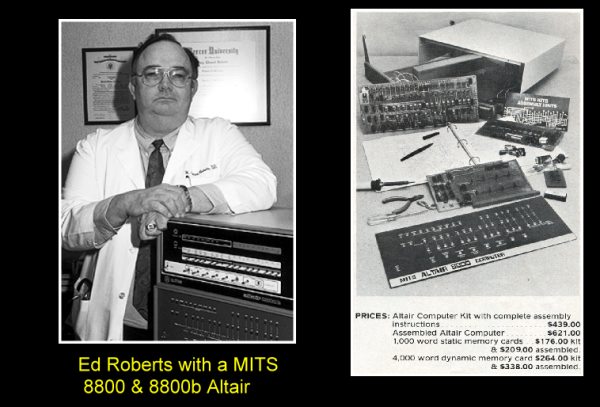
MITS - History

Much has been written about the early
history of MITS and the Altair. I will only briefly summarize it here.
The company was founded by Edward
Roberts and 3 other fellow US Air Force acquaintances in 1969 in Albuquerque New
Mexico, where they were stationed before they retired. MITS stands for
Micro Instrumentation and Telemetry Systems. They initially made radio
control systems for model rockets. It was not a great success. Ed bought his partners
out and refocused the company on selling kit electronic calculators. One was
featured in Popular Electronics and initially it was a great success.
However when Texas Instruments got into the calculator business in the early
1970's the market collapsed. Ed started to look around for something
else to sell in kit form.
Quite unrelated but at the same time the
editor of Popular Electronics (Les Solomon) was looking around for an
article on a kit computer hobbyist could build for his magazine. This was
spurred on by an earlier article in the competing magazine Radio Electronics
describing a primitive hobbyist computer (the Mark-8) utilizing an Intel 8008
CPU. He contacted Ed who had written articles for him in the past about
writing a computer kit for him.
The timing was right. Ed was playing
around with the idea of making a computer kit utilizing an Intel 8080 CPU
anyway. He could get the CPU's at a discount for $75 each if he could sell
in volume. His goal was to have an 8 bit computer kit for hobbyist for
less that $400. The only problem was time. Solomon wanted the finished
product for the January 1975 issue of
Popular Electronics. Ed and
two of his staff worked non-stop to meet the deadline. They wanted to have a bus
structure (as the Mark-8 had) so the kit could be expanded later with other
components thereby increasing sales revenue. In their scramble for low
priced components they came across a deal on 100 pin connectors that seem to fit
the need. The decided to layout their boards with 100 pin edge connectors.
In the rush unfortunately no great care or thought was given to optimum signal
placements, ground lines etc. Their computer had one front panel board, an
8080 CPU board and a 1K RAM board. They called the computer the Altair.
As a side note, one of MITS cofounders
Forrest Mims
wrote the Altair documentation. He went on to be one or the most prolific
authors in the computer industry.
After the write-up appeared in Popular
Electronics demand for the kit exploded. They had budgeted to sell a few hundred
kits. They sold 1000's in the first few months alone.
Ed refocused MITS to be a
micro-computer company. His next project was to add more memory to the
computer. They designed, built and sold a 4K dynamic RAM card as an add-on
to this "Altair bus". Unfortunately the design was faulty and did not work
reliably. Furthermore MITS was having problems meeting the demand
for its kits. This allowed other companies such as
IMSAI,
NorthStar,
Processor Technology etc. to get started and offer kit memory boards for the
Altair. It was not long before they were making their own Altair like computers.
Nevertheless the initial start gave
MITS an early lead in the virgin market. In 1976 and 1977 the company grew
rapidly. The company also had one other advantage, it was the computer Bill
Gates utilized to developed his 4K Basic/Microsoft interpreter for. Only
later did Bill branch out and license his software to other manufactures. This
was a time before floppy disks, where software was delivered via paper
tape or possibly a cassette. Initially the main competition was IMSAI. The
latter had better hardware implementations and definitely better marketeering.
MITS came out in 1977 with the Altair 8800b, an improved version of the Altair.
However the company got side tracked and jumped from the Intel 8080/Z80 CPU's to
the Motorola 6800 chip that same year coming out with the Altair 680b.
Ed Roberts began to feel the company
was growing too fast for him. He still remembered the growth and collapse of his
calculator business and decided to sell MITS that year to Pertec, the disk drive
manufacture (for $6.5M). Ed dropped out of the computer business and went
on to be a medical doctor -- something he always wanted to do.

With Pertec's help, MITS quickly
implemented a disk drive interface for Altair's. They also made the
mistake initially of trying to force the use of their own disk operating system/software
on users rather than the then popular CP/M system used by others. By the
end of the decade MITS and its S-100 bus products was gone. MITS just could not
make the transition from a hobbyist driven business to a "normal" plug-and-play
customer business that were often intimidated by the likes of led's, switches
and cryptic instructions.
MITS S-100 Boards
1K RAM
4K RAM
4K Dynamic RAM
16K RAM
16K Dynamic RAM
4PIO
8080 CPU VI/RTC
PCI ADC
2K PROM
8K PROM
88-2 SIO
SIO-B
MITS FDC Boards
This page was last modified
on
01/08/2011



